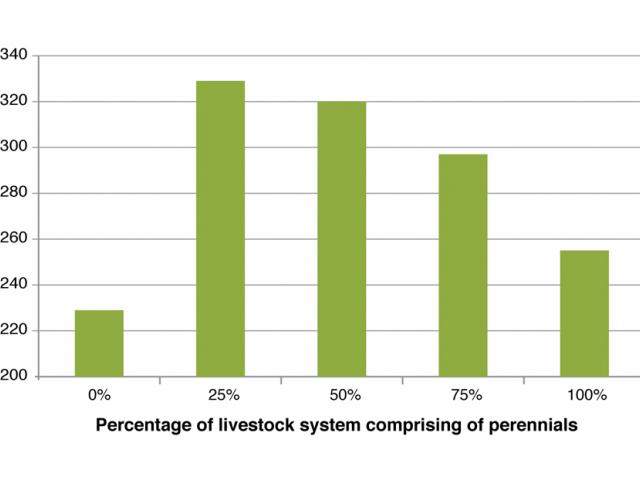Summary
The EverGraze project had ambitious goals:
- significantly increase profitability of livestock enterprises above local benchmarks and simultaneously reduce ground water recharge
- reduce soil loss by water and wind
- improve soil health (including acidity and salinity)
- improve biodiversity.
To achieve these aims, the project applied a set of principles, which can be summarised as 'putting the right plant in the right place for the right purpose with the right management'.
The Western Australian node focused on a proof site on the Albany Sandplain. This was a farmlet scale trial that incorporated a range of perennial systems built around a prime lamb system. Monitoring data from the proof site was then used to validate a GrassGro model that was used to simulate and trial a range of pasture types and mixes and determine the impact on production and profitability. There was also several satellite and case study sites scattered across the high rainfall south coast.
In Western Australia (WA) the research team investigated the use of kikuyu, lucerne, chicory, tall fescue and panic to increase profit from prime lamb production and reduce land degradation. Research and modelling showed a number of clear benefits from incorporating perennial pastures into the farming system.
These were refined down to key messages that highlighted the main findings from the research and modelling. These are:
- Adding 25% perennials to farming systems on the south coast of WA will give the highest gross margins.
- Deep-rooted summer active perennials kikuyu, lucerne and chicory extend the growing season and reduce the need for supplementary feed in summer and autumn compared to annual based pasture systems in the south coast of WA.
- Kikuyu, chicory and panic persist through dry seasons.
- Chicory and lucerne extend the growing season and provide quality feed in a lamb finishing system.
A longer growing season also provided other important benefits by allowing the shifting of the optimum time of lambing to June or July rather than May when there was greater than 25% under perennials (Figure 2). The introduction of perennials also reduced supplementary feeding whilst maintaining groundcover and soil stability.
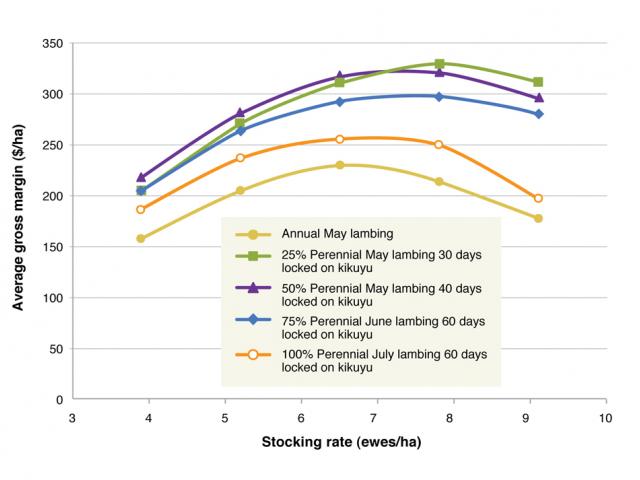
For more detailed information, please see the Evergraze website.
Perennials provide green feed outside growing season – quality and quantity
Deep-rooted summer active perennials kikuyu, lucerne and chicory, extend the growing season and reduce the need for supplementary feed in summer and autumn compared to annual based pasture systems in south-coast WA.
|
| J | F | M | A | M | J | J | A | S | O | N | D | Average annual yield kg/DM/ha |
|---|---|---|---|---|---|---|---|---|---|---|---|---|---|
| Kikuyu | 13 | 13 | 13 | 14 | 16 | 17 | 24 | 39 | 40 | 35 | 24 | 14 | 8011 |
| Lucerne | 10 | 9 | 9 | 12 | 13 | 16 | 19 | 27 | 32 | 33 | 26 | 14 | 6752 |
| Chicory | 7 | 6 | 9 | 11 | 11 | 12 | 12 | 14 | 17 | 20 | 16 | 9 | 4404 |
| Annual | 6 | 9 | 9 | 16 | 22 | 32 | 39 | 48 | 44 | 36 | 14 | 7 | 8567 |
Kikuyu recorded the highest dry matter production at the EverGraze proof site in Wellstead during summer. Overall the perennials were able to produce over 10kg DM/ha/day in November and December (Figure 3). This is of course highly dependent on rainfall however modelling showed it could be as high as 24kg DM/ha/day (Table 1).
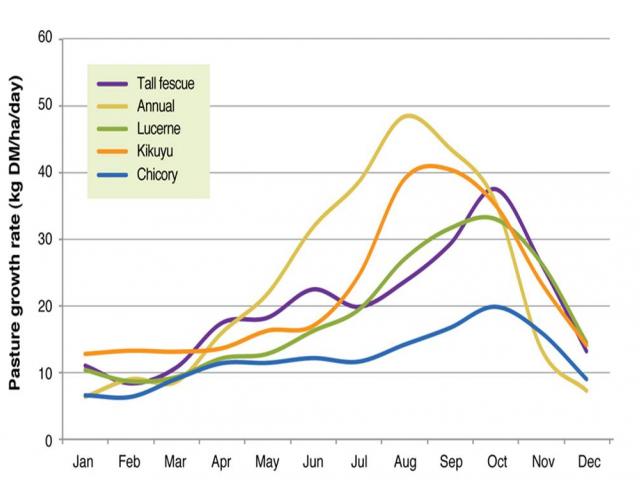
Lucerne and chicory provided quality out of season feed with summer/autumn dry matter digestibility of around 70% for lucerne and 80% for chicory (Figure 4). Total production for the perennial swards was similar to the annuals at 6t/ha however winter production was slightly lower in Wellstead.
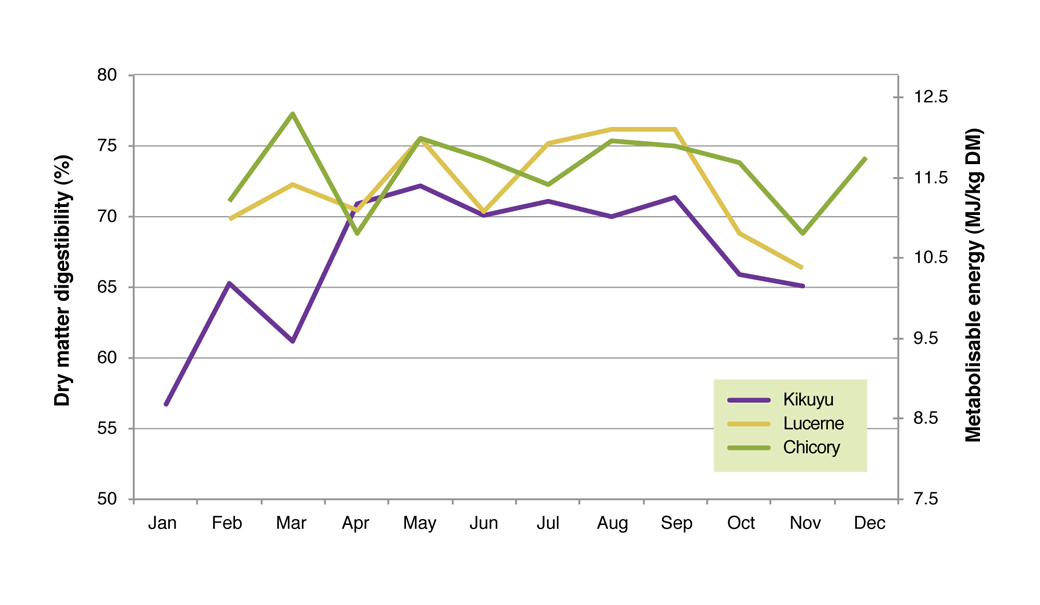
For more detailed information, please see the Evergraze website.
Kikuyu, chicory and panic persist through dry seasons
Deep-rooted summer active perennials kikuyu, chicory and panic survived three drought years at the EverGraze proof site in Wellstead, while summer-active tall fescue failed and lucerne declined over the same period.
Basal cover measurement showed that the chicory and panic maintained and even increased basal cover over a tough three years. This was due to the plants increase in size and in the case of the chicory some recruitment (Figure 5).
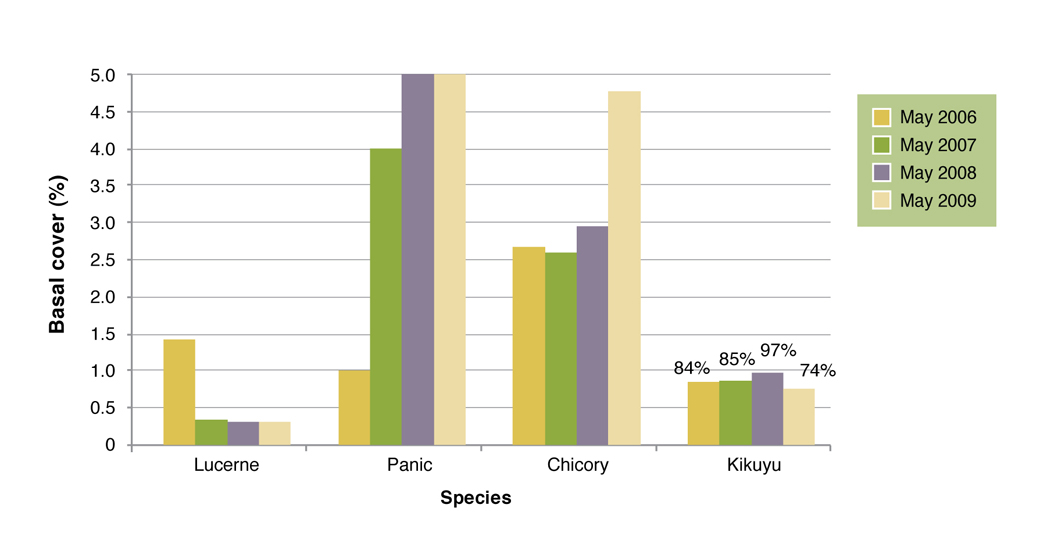
Lucerne has the potential to provide a very good finishing system. It was able to drive lamb growth rates of 232 grams per head per day (g/hd/day), however it was not able to persist on the soils on the proof site. This was in contrast to the kikuyu that was able to persist very well and was able to provide good maintenance feed for ewes but was not able to finish lambs due to the lower quality (Tables 2 and 3).
| Sample | Date | Dry matter digestibility (%) | Crude protein (%) | Metabolisable energy (MJ/kg) |
|---|---|---|---|---|
| Chicory | 15/09/2008 | 82 | 26 | 12.4 |
| Lucerne | 15/09/2008 | 76 | 27 | 11.5 |
| Kikuyu | 15/09/2008 | 72 | 19 | 10.8 |
| Chicory | 19/11/2008 | 78 | 18 | 11.8 |
| Lucerne | 19/11/2008 | 69 | 26 | 10.3 |
| Kikuyu | 19/11/2008 | 66 | 13 | 9.7 |
| Straw | 12/5/2008 | 34 | 2 | 4.2 |
| EasyOne | — | 69 | 16 | 11.5 |
| Grazing period | Days | Pastures grazed | Initial lwt (kg) | Final lwt (kg) | ADG (g/hd/day) |
|---|---|---|---|---|---|
| 9 Oct-23 Nov | 46 | Fescue, kikuyu, panic, lucerne | 25.7 | 30.4 | 102 |
| 22 Dec–29 Dec | 8 | Lucerne | 34.3 | 36.2 | 232 |
| 8 Jan–26 Jan | 19 | Kikuyu, panic, lucerne | 38.2 | 38.4 | 11 |
| 27 Jan–22 Feb | 31 | Kikuyu, chicory | 33.0 | 35.6 | 84 |
Links to external sites
All information including research findings, papers, tools and extension material has been collated from the participating sites in Western Australia, Victoria and New South Wales. This has been placed onto a website that has been designed to allow producers and advisor access to all information in an easy to access and convenient format.
Packages have been developed targeting specific zones in each state. Key research findings are accessible though the regional package or directly from the home page plus updated information and tools.
Visit Evergraze for further information.

